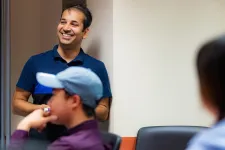(Press-News.org) With a lethal, airborne virus spreading fast, hospitals had to change how they treated patients and policies for how caregivers provided that treatment. But for maternity patients and nurses some of those changes had negative outcomes, according to a new University of Washington study.
"We found that visitor restrictions and separation policies were harming families and nurses. The effects for patients included loneliness, isolation and mistrust, while nurses described mistrust and low morale," said Molly Altman, lead author of the study and assistant professor in the UW School of Nursing.
Importantly, Altman added, both nurses and patients described how COVID "amplified existing racially biased and disrespectful care experiences for Black women and birthing people, in part due to loss of protection and advocacy that support people provide."
The study, published March 31 in Global Qualitative Nursing Research, involved in-depth interviews with 15 patients from Washington state and 14 nurses from Washington, New York, Georgia and Michigan. Nearly half of participants in both groups self-identified as BIPOC and for slightly more than half this was their first birth.
Under COVID-19 restrictions, patients experienced a shift from in-person visits, a source of social and emotional support, to virtual conversations or telehealth and more perfunctory exchanges in offices with physical distancing. Pregnancy education and group classes all moved online, while family and friends were excluded from patient care when in the hospital or clinic. Meanwhile, nurses experienced shifting policies and procedures that led to a collective mistrust of management and administration.
In the interviews, researchers wrote, patient responses focused on how hospital adaptations "were inadequate to meet their needs" and, in addition to mistrust, nurse responses focused on how inconsistencies in policies and policy implementation affected their ability to "safely care for patients."
Here are a few verbatim transcriptions of statements patients gave researchers (with minor edits):
About telehealth ...
I want to be able to actually have a check-in and actually have a doctor be able to check everything's fine and make sure the baby's heartbeat is still okay or see how my uterus is measuring and things like that that are more concrete. ... I see the phone conversation just more being like, "Is everything okay," and me saying "Yes" and then that kind of being it.
Communication with providers ...
We don't talk about how this is affecting us or what it means for the future. It's just they leave you hanging like, "Okay, well I'm guessing everything's okay so I'm just going to walk on out of here." But if you could just say something nice, concise and brief but meaty it would be perfect.
Education and nursing support ...
I lost ... the classes that we were supposed to need. I was so excited to join those classes because I could get a chance to meet with other mothers that we may build connections, right? But because of COVID we just don't have the chance of doing that.
People were there [in labor] to support me and to make sure I was okay and then I felt like postpartum everyone disappeared.
Racial bias ...
Being [a person] of color, you already kind of deal with the standoffish approach from certain people and so like ... the virus kind of gives [them] that reason to, it's just like that. It's like even though I already feel this way, now I have a reason to act this way.
I'm an educated Black woman. I'm a nurse. I know what's going on with my body and I know how this stuff works and I still feel like so inferior, like to my [birth] team. That's crazy to me.
Following are a few verbatim transcriptions of statements nurses gave researchers (with minor edits):
Lack of planning ...
I was disappointed to see that in the, at least a month, more like six weeks since we'd had just the one COVID patient, that not a lot had been done to prepare in the meantime, both on a national scale and just at our hospital.
Policy changes ...
I felt like at times on my shift, policies would change literally every 15 to 30 minutes. You do something one way and you get an email within the hour that this now has changed and we're doing this procedure this way and it was just constant like nobody knows what they're doing so it was very stressful.
Morale problems ...
I'm just doing everything for this patient and then I'm not thinking about my own family. Even if I [say] let whatever happen to me ... I have responsibilities for my family too. I'm not just a nurse, right? I'm a mother. When I took the oath to be a nurse, before that maybe I took an oath to be a good mother.
[a patient complained and] that stung because I remember going to my manager's room that day and asking for more supplies so that I could go into the room more frequently without having to break the gowns and reuse the gowns and she said, "You use what you have and I'm not giving you anything else."
Racial bias ...
[obstetrical resident physician] went in to go talk to [a patient] about the need for induction and instead of including the father in the conversation or even introducing herself, she went in, completely turned her back on the dad ... I've been there 10 years and I have never seen that with any Caucasian couple.
"We need to really center the voices and experiences of marginalized people, especially BIPOC, in policy. We need to ensure that communication is transparent and that we are trustworthy to the groups we develop policies for -- patients, nurses, the public, everyone," said Meghan Eagen-Torkko, study co-author and assistant professor in UW Bothell School of Nursing and Health Studies. "We have to stop thinking of policy as a top-down process, because Covid has shown us quite clearly that this doesn't work."
INFORMATION:
Co-authors include Amelia Gavin, UW School of Social Work; Selina Mohammed, UW Bothell School of Nursing and Health Studies; Ira Kantrowitz-Gordon, UW School of Nursing, Seattle; and Rue Khosa, The Perfect Push, LLC in Redmond. This research was funded by UW School of Nursing, Seattle.
For more information, contact Altman at mraltman@uw.edu.
[Inset BOX]
Altman, who spoke to UW News in December about this issue, suggests health care administrators take the following actions to counter the failures of current policies:
Administrators need to collaborate on policy changes, particularly with communities that are directly affected by these changes
Consider extending visitor policies to include multiple support people for patients in labor, as a way to mitigate risk of disrespectful care for marginalized communities
Create educational resources to help patients understand policies that affect them and provide avenues for getting support and reassurance
Develop clear, organized and transparent communication pathways about policy changes at all levels: patient, nurse and management
Increase mental health assessment, support and services for both patients and nurses to help build well-being amid crisis
Include bedside nurses in decisions about care planning, risk management and patient care
LA JOLLA--(April 7, 2021) When cells are stressed, chemical alarms go off, setting in motion a flurry of activity that protects the cell's most important players. During the rush, a protein called Parkin hurries to protect the mitochondria, the power stations that generate energy for the cell. Now Salk researchers have discovered a direct link between a master sensor of cell stress and Parkin itself. The same pathway is also tied to type 2 diabetes and cancer, which could open a new avenue for treating all three diseases.
"Our findings represent the earliest step in Parkin's alarm response that anyone's ever found by a long shot. ...
New medicines for people who have diabetes seem to pop up all the time. Drugs that help the body break down carbohydrates, drugs that increase excretion of glucose in the urine, drugs that help muscles respond to insulin and drugs that stimulate the pancreas to produce it -- the list of pharmaceutical options to treat diabetes gets longer and longer.
The downside of this wealth of treatment options is that it can be difficult for health care providers to stay on top of the latest research and standards of care. Which medication is best for which patients? And what are the best medicines to prescribe that both lower blood glucose and reduce risk for cardiovascular disease?
Johns Hopkins Medicine endocrinologist ...
How many species of birds are there in the world? It depends on whose count you go by. The number could be as low as 10,000 or as high as 18,000. It's tough to standardize lists of species because the concept of a "species" itself is a little bit fuzzy.
That matters because conserving biodiversity requires knowing what diversity exists in the first place. So biologists, led by University of Utah doctoral candidate Monte Neate-Clegg of the School of Biological Sciences, set out to compare four main lists of bird species worldwide to find out how the lists differ--and why. They found that although the lists agree on most birds, disagreements in some regions ...
A new analysis of lung epithelial cells from COVID-19 patients reveals how the protective complement branch of the immune system, which usually plays roles in both innate and adaptive immunity, can convert to a harmful system during COVID-19. Blocking excessive complement activity in lung epithelial cells with a combination of existing chemotherapy and antiviral medications - ruxolitinib and remdesivir, respectively - helped normalize the production of complement proteins by infected lung epithelial cells in human cell culture experiments, the researchers found. Thus, the drug duo could serve as a promising strategy to treat damaging inflammation during severe COVID-19, the authors say. Overactivation of complement proteins can contribute to diseases such as acute respiratory distress ...
HERSHEY, Pa.-- Social distancing and lockdowns may have reduced the spread of COVID-19, but researchers from Penn State College of Medicine also report those actions may have affected clinical researchers' ability to finish trials. Study completion rates dropped worldwide between 13% and 23%, depending on the type of research sponsor and geographic location, between April and October 2020.
Researchers previously reported that more than 80% of clinical trials suspended between March 1 and April 26, 2020, noted the pandemic as their chief reason for halting activity. Patient enrollment in studies was lower in April 2020, compared to April ...
WYOMISSING, Pa. -- Teaching people to become entrepreneurs requires more than just passing on entrepreneurial skills, according to a team of Penn State Berks-led researchers. Would-be entrepreneurs also need to understand -- and negotiate -- the barriers that they might face.
In a study, researchers built a multidimensional model to measure the effectiveness of entrepreneurship education. The model not only includes teaching entrepreneurial skills, but also addresses the students' intentions to start a business and their perceptions of the barriers they might encounter when starting a business.
"There are a lot of studies in the literature that focus on, for example, how entrepreneurship education ...
HOUSTON -- (April 7, 2021) -- Rice University computer scientists have demonstrated artificial intelligence (AI) software that runs on commodity processors and trains deep neural networks 15 times faster than platforms based on graphics processors.
"The cost of training is the actual bottleneck in AI," said Anshumali Shrivastava, an assistant professor of computer science at Rice's Brown School of Engineering. "Companies are spending millions of dollars a week just to train and fine-tune their AI workloads."
Shrivastava and collaborators from Rice and Intel will present research that addresses that bottleneck April 8 at the machine learning systems conference MLSys.
Deep neural networks ...
In an article published in the April 8 issue of Nature, the National Institutes of Health's Somatic Cell Gene Editing Consortium provided a detailed update on the progress of their nationwide effort to develop safer and more effective methods to edit the genomes of disease-relevant somatic cells and reduce the burden of disease caused by genetic changes.
Gene editing allows scientists to modify sections of an organism's DNA and is considered a promising treatment for a number of genetic diseases. There have been numerous advances in the laboratory over the last few decades, but there are still many challenges to overcome before gene editing can be widely used in the patient population. Launched in 2018, the Somatic Cell Gene Editing Consortium ...
A natural brilliant blue coloring has been discovered by an international team of researchers including chemists at the University of California, Davis. The new cyan blue, obtained from red cabbage, could be an alternative to synthetic blue food colorings such as the widely used FD&C Blue No. 1. The work is published April 7 in Science Advances.
"Blue colors are really quite rare in nature - a lot of them are really reds and purples," said Pamela Denish, a graduate student working with Professor Justin Siegel at the UC Davis Department of Chemistry and Innovation Institute for Food and Health.
Having ...
Scientists have developed a long-sought naturally derived cyan blue colorant sourced from red cabbage anthocyanin pigments that may offer an alternative to the industry standard blue dye, although more testing is needed to determine the compound's safety. The novel colorant, which was developed using an enzyme that converts a range of anthocyanins to one with the ideal wavelength, remains highly stable over time and may also produce better green colors than those derived from existing natural blue colorants. Several research programs around the world are dedicated to the hunt for a natural alternative to FD&C Blue No.1 - a challenging effort given that cyan blue is one of the rarest colors in nature. While previous research has shown that ...



